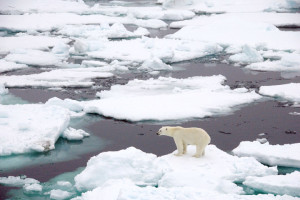By Jason Klein, Environmental Writer and Editor
The molecule methane (CH4) can be found on many planets in our solar system, including Earth. Its presence is essential for life as we know it, and can be found in the guts of cattle and termites. Methane is also a by-product of plant decomposition, and is the major component of natural gas, accounting for about 87% by volume. Thus, methane is just as much a part of our lives as oxygen, carbon, or water.
Methane can be helpful, but it can also be harmful. Not only can methane contribute to the breakdown of the ozone layer (which protects us from harmful solar radiation), but it is also a potent greenhouse gas. In fact, recent research from Liverpool John Moores University suggests that methane produced by dinosaurs may have warmed our planet enough to hasten their downfall– and allowing mammals, including humans, to rise!
Today, one of the most surprising sources of methane is the Arctic Ocean. As the region warms due to climate change and sea ice melts, the water releases significant amounts of the gas, according to a recent study published in the journal Nature Geoscience. In 2009 and 2010, a specially equipped plane was able to detect methane levels roughly equivalent to the eastern Siberian Arctic shelf. Due to the much larger size of the Arctic Ocean, however, scientists would need to adapt their models for future climate change projections. Additionally, as the Earth’s temperature rises, a positive feedback loop is created (more on feedbacks in the climate system coming soon); as more sea ice melts, more methane is discharged, trapping more heat, and so on.
In 2010, methane levels in the Arctic were measured at a level over twice as high as at any time in the previous 400,000 years. As more methane is released into the atmosphere – from melting Arctic sea ice, tundra, and humanity’s burgeoning appetite for meat – more attention needs to be paid to this important greenhouse gas.
References
Kort, et al. “Atmospheric observations of Arctic Ocean methane emissions up to 82° north.” Nature Geoscience. April, 2012. 318-321.
FAO (2006). Livestock’s Long Shadow–Environmental Issues and Options. Rome: Food and Agriculture Organization of the United Nations (FAO). http://www.fao.org/docrep/010/a0701e/a0701e00.HTM.


Comments are closed.